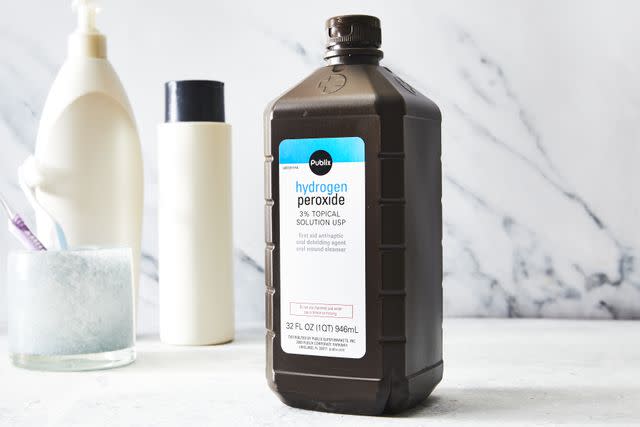6 Ways To Use Hydrogen Peroxide In Your Home
Fact checked by Khara Scheppmann
Many people likely have a brown bottle of hydrogen peroxide under their bathroom sink. Hydrogen peroxide is a good disinfectant to use on cuts and scapes, but this disinfectant isn’t only useful for cleaning up torn skin. Hydrogen peroxide can be used in many areas of the home to disinfect.
“Hydrogen peroxide is a powerful sanitizer and disinfectant, non-toxic, and environmentally friendly,” says Lisa Sharp, a cleaning expert and the founder of Retro Housewife Goes Green in Oklahoma. “It can effectively kill bacteria, viruses, and mold spores, making it an excellent choice for maintaining a clean home without the use of harsh chemicals.” Here are different ways to use hydrogen peroxide in your home.
Meet The Experts
Lisa Sharp, cleaning expert and founder of Retro Housewife Goes Green in Oklahoma
Alex Varela, General Manager of Dallas Maids; Dallas, Texas
Clean Surfaces With Grease
Have a baking tray or cooking surface with food residue or grease? Reach for hydrogen peroxide to make cleaning easier. Alex Varela, General Manager of Dallas Maids recommends mixing hydrogen peroxide and baking soda together until you form a paste. Apply the paste to the area where there is grease or food remnants and then allow it to sit for eight hours. Then, scrub it away with a non-scratch sponge.
Disinfect Toothbrushes
Toothbrushes are important for dental hygiene but we may not always consider that these essential brushes need cleaning, too. Sharp explains that disinfecting your toothbrush will help kill bacteria and germs that could be on the bristles.
Ready to disinfect your toothbrush? “Pour a small amount of hydrogen peroxide into a cup or glass [and] submerge the bristles of your toothbrush in the hydrogen peroxide and let it sit for a few minutes [and] rinse well when done,” says Sharp. “This helps kill bacteria and germs that may be present on the bristles.”

Caitlin Bensel
Multi-Purpose Cleaner
“Hydrogen peroxide can be used to disinfect countertops, cutting boards, bathroom fixtures, and more,” says Sharp. Want to make your own all-purpose cleaner? Hydrogen peroxide and water make a good combination. Sharp explains that you want a mixture of 50/50 peroxide and water. When you’re ready to use it, you’ll want to spray the surface and then let it sit for a minimum of five minutes.
And if you want a cleaner with a nice scent, Sharp suggests adding a couple of drops of essential oil. But she cautions, “Just be mindful that some essential oils can be harmful to pets and small children.”
Stain Remover
Let’s face it, there are so many opportunities in your day-to-day routine where stains can occur, whether it’s eating your favorite soup, enjoying a slice of juicy watermelon, or even sweating. Turns out, hydrogen peroxide is a great stain remover.
“Hydrogen peroxide bubbling action helps to lift stains from fabrics, carpets, and upholstery,” says Sharp. “This use is helpful because it can effectively tackle tough stains without the need for harsh chemicals, keeping your surfaces and fabrics clean and fresh.” But before you start using hydrogen peroxide as your new go-to stain remover, make sure to test it on an inconspicuous area of the fabric to ensure it doesn’t cause discoloration.
Toilet Bowl Cleaner
When it’s time to clean the bathroom, you likely have a specific toilet bowl cleaner. Whether you prefer to use less toxic cleaners in your home or like to streamline your cleaning routine, hydrogen peroxide also works wonders for cleaning the toilet. “Its disinfecting properties make it an effective cleaner for removing stains, mineral deposits, and odors from the toilet bowl,” says Sharp.
And it’s easy to clean with this disinfectant. “Simply pour hydrogen peroxide into the bowl, let it sit for a few minutes, scrub it with a toilet brush, and flush,” says Sharp. “This method helps to keep your toilet clean and fresh without the need for harsh chemical cleaners.”
Grout Whitener
Is your tile and grout in need of whitening? Bring hydrogen peroxide to the rescue. “Its effervescent properties can help remove dirt, grime, and stains from tiled surfaces, leaving them clean and refreshed,” says Sharp.
To get started, you’ll want to make a paste combining hydrogen peroxide with baking soda. Verela shares that you’ll apply the mixture to the grout with an old toothbrush and let sit for half an hour before scrubbing in a circular motion.
For more Southern Living news, make sure to sign up for our newsletter!
Read the original article on Southern Living.

